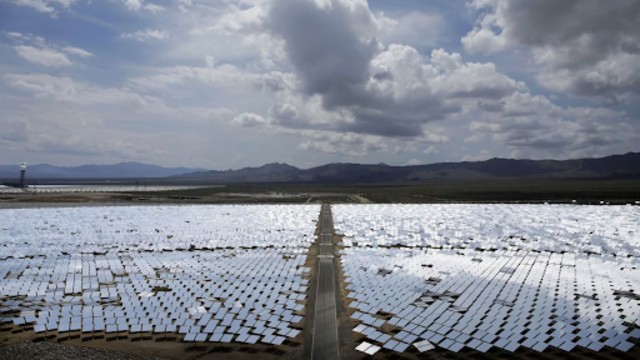
A collection of mirrors at the Ivanpah solar power plant is seen near Primm, Nevada, on August 13, 2014. (AP Photo)
The Ivanpah solar power plant, once the world’s largest of its kind, is facing the possibility of closure just 11 years after it opened, primarily due to the rise of cheaper and more efficient green energy technologies. Environmental concerns over the plant’s impact on local wildlife, including the deaths of thousands of birds and tortoises, have further complicated its future.
Located near the California-Nevada border, Ivanpah covers approximately five square miles of federal land and was celebrated as a breakthrough in clean energy when it opened in 2014. Using solar-thermal technology, Ivanpah employs nearly 350,000 computer-controlled mirrors to reflect sunlight onto boilers atop 459-foot towers. The heat from the sun creates steam to drive turbines that generate electricity.
Despite its initial success, Ivanpah has struggled to compete with newer, less expensive solar technologies, particularly photovoltaic (PV) solar systems, which are more cost-effective to build and operate. PV solar technology, such as rooftop panels, has lower capital and maintenance costs, making it the preferred choice in the renewable energy sector.
Pacific Gas & Electric (PG&E), one of the main buyers of Ivanpah’s energy, announced it had agreed to end its contracts with the plant, which were supposed to last until 2039. If approved by regulators, this would result in the shutdown of two of Ivanpah’s three units by 2026. PG&E stated that this decision would save money for its customers. Similarly, Southern California Edison, which purchases the remaining power from Ivanpah, is discussing a possible buyout of its contract with the plant’s owners and the U.S. Energy Department.
Although the plant initially offered a competitive price for energy, NRG Energy, one of its main owners, acknowledged that advancements in photovoltaics and battery storage have led to more efficient and cost-effective methods of producing reliable clean energy. NRG also noted that while Ivanpah’s technology had worked on a smaller scale in Europe, it was ultimately unable to compete with the rapidly declining costs of PV solar systems.
Beyond its economic challenges, Ivanpah has faced significant environmental criticism. The plant’s massive mirrors, which reflect sunlight to generate heat, have been blamed for causing the deaths of thousands of birds, which are burned by the intense heat. Conservationists also opposed the plant’s construction due to the threat it posed to local wildlife, especially desert tortoises. Julia Dowell of the Sierra Club described the project as a “financial boondoggle and environmental disaster,” criticizing the destruction of irreplaceable desert habitat and rare plant species.
In addition to these environmental concerns, the plant did not perform as expected in terms of energy production, largely due to the inconsistent weather patterns and the lack of sun during certain times of the year.
Despite its challenges, the plant’s owners see the potential for the site to be repurposed for photovoltaic energy production if the decommissioning process moves forward. However, questions about the future of the equipment and the costs involved remain unanswered.
The Ivanpah plant’s decline highlights the rapid changes in the renewable energy industry, where older technologies struggle to keep up with newer, more efficient systems.















